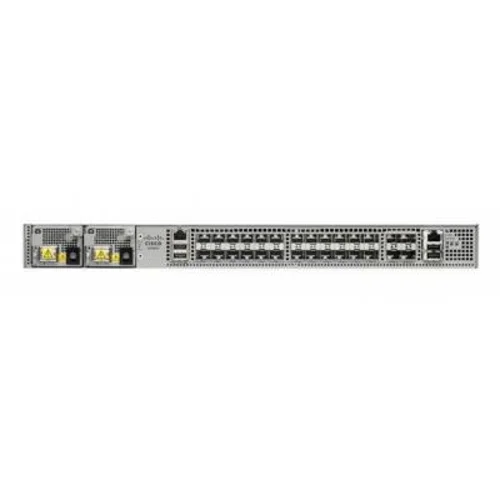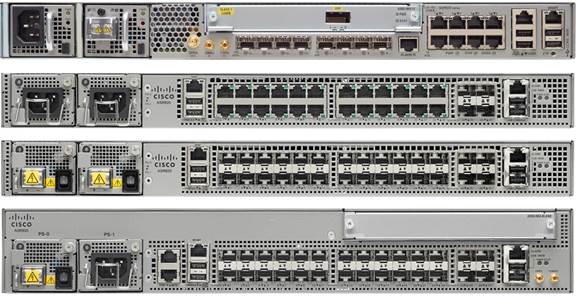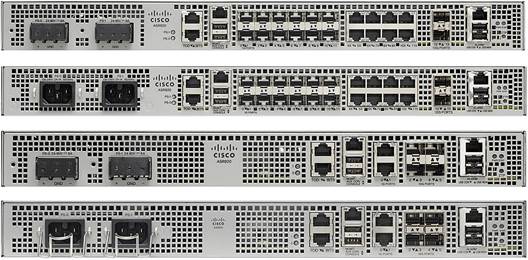В комплект входит:
- блоки питания ASR-920-PWR-D - 2 шт
- функционал Advanced Metro IP Access (активированные порты 1/10GE)
Маршрутизаторы Cisco ASR 920 Series Aggregation Services Router (ASR) серии являются превосходным конвергетным решением для задач уровня доступа и агрегации. Данные маршрутизаторы имеют малые размеры, низкое энергопотребление, расширенный диапазон рабочих температур и обладают при этом большой пропускной способностью (до 64Gbps)! Компактные 1U-шасси ASR 920 поставляются в различных комбинациях 1G (RJ45/SFP) и 10G (SFP+) портов. Предусмотрена возможность установки модуля расширения Inetrface Module - IM, который позволяет реализовать дополнительные Ethernet и TDM-интерфейсы, в том числе для реализации сервисов телефонии.
Cisco ASR 920 Series одновремено обладают полным функционалом L2 коммутатора и L3 маршрутизатора - L2VPN/L3VPN, MPLS/VPLS, QoS/HQoS, RIP/EIGRP/OSPF/BGP, PIM/MULTICAST, QinQ, IPSec, ACL, PoE. Компактные размеры, полный функционал, гибкая плотность портов и промышленный диапазон рабочих температур позволяют расширить операторам зону своих сервисов в удаленные, менее обслуживаемые места, без высоких затрат на размещение, электропитание и кондиционирование оборудования.
Ключевые особенности серии ASR-920:
- 1U - форм-фактор;
- Глубина менее 300мм;
- Низкое энергопотребление - менее 130 Вт (типовое);
- Два фиксированных или модульных блока питания AC/DC;
- Расширенный диапазон рабочих темперетур -40 ... 70ºC;
- До 24 портов 1G RJ45/SFP, до 4 портов 10G SFP+:
- Поддрежка PoE до 60Вт/порт (PoE, PoE+, UPOE);
- Опциональные модули расширения Ethernet интефейсов - 8x1G RJ45, 8x1G SFP, 8x1G Combo RJ45/SFP & 1x10G SFP+, 1x10G XFP, 2x10G SFP+/XFP;
- Опциональные модули TDM интерфейсов - 8xE1/T1, 16xE1/T1, 32xE1/T1, 4xOC3/STM1, 1xOC12/STM4;
- Cisco IOS® XE Software;
Описание на сайте производителя
Производитель: Cisco
| Features | Metro Access License | Metro IP Access License | Advanced Metro IP Access License |
| QoS, with deep buffers and hierarchical QoS (HQOS) | √ | √ | √ |
| Layer 2: 802.1d and 802.1q | √ | √ | √ |
| Ethernet Virtual Circuit (EVC) | √ | √ | √ |
| Ethernet OAM (802.1ag and 802.3ah) | √ | √ | √ |
| Multiple Spanning Tree (MST) and Resilient Ethernet Protocol (REP) | √ | √ | √ |
| Synchronous Ethernet | √ | √ | √ |
| IPv4 and IPv6 host connectivity | √ | √ | √ |
| IP routing (Routing Information Protocol [RIP], Open Shortest Path First [OSPF], Enhanced Interior Gateway Routing Protocol [EIGRP], Border Gateway Protocol [BGP], and Intermediate System-to-Intermediate System [IS-IS]) | √ | √ | |
| Protocol-independent multicast (PIM) (sparse mode [SM], dense mode [DM], source-specific multicast [SSM]), SSM mapping | √ | √ | |
| BFD | √ | √ | |
| Multi-VRF CE (VRF lite) with service awareness (Address Resolution Protocol [ARP], ping, Simple Network Management Protocol [SNMP], syslog, trace-route, File Transfer Protocol [FTP], and Trivial File Transfer Protocol [TFTP]) | √ | √ | |
| IEEE 1588-2008 Ordinary Clock and Transparent Clock | √ | √ | |
| MPLS (Label Distribution Protocol [LDP] and VPN) | √ | ||
| MPLS TE and fast reroute (FRR) | √ | ||
| MPLS OAM | √ | ||
| MPLS-TP | √ | ||
| Pseudowire emulation (EoMPLS, CESoPSN, and SAToP) | √ | ||
| Virtual Private LAN Service (VPLS) and Hierarchical VPLS (HVPLS) | √ | ||
| Pseudowire redundancy | √ |
| Ethernet Services ● Ethernet Flow Point (EFP) with support for: ◦ 802.1q◦ Selective QinQ ◦ Inner and Outer VLAN classification ◦ VLAN local significance ◦ One VLAN tag ingress push ◦ Pop one VLAN tag◦ Pop two VLAN tags ◦ Trunk-EFP construct for configuration simplification ● IEEE 802.1s Multiple Spanning Tree (MST) ● Resilient Ethernet Protocol (REP) ● ITU G.8032● 802.3ad/802.1ax Link Aggregation Control Protocol (LACP) ● Layer 2 Protocol Tunneling (L2PT) ● VPLS, HVPLS, Virtual Private Wire Service (VPWS), and EoMPLS ● Pseudowire redundancy ● Hot Standby Pseudowire ● Multisegment Pseudowire ● Dual Rate |
| Layer 3 and MPLS Services ● Hot Standby Router Protocol (HSRP) ● Layer 3 routing on Routed interfaces and Bridge Domain Interfaces (BDI) ● Cisco Express Forwarding (CEF) load sharing of Equal Cost Paths (ECMP) ● OSPF ● BGP ● BGP 4-byte Autonomous System number (ASN) ● BGP TCP Path MTU Discovery ● BGP Prefix-Independent Convergence (PIC) Edge and Core for IPv4 and MPLS VPN ● IS-IS ● BFD for OSPF, IS-IS, BGP, and static routes ● BFD over Ethernet, Routed port interfaces ● BFD for HSRP group client ● MPLS ● LDP with Label Edge Router (LER) and Label Switch Router (LSR) ● MPLS L3VPN ● MPLS-TP for Ethernet Pseudo Wires ● MPLS Traffic Engineering Fast Reroute (TE-FRR) ● IP Loop Free Alternate Fast Re-Route (LFA FRR) ● Remote Loop Free Alternate Fast Re-Route (R-LFA FRR) |
| IPv6 ● Hardware based IPv6 data forwarding ● Addressing and discovery ● Manual IPv6 interface addressing ● ICMPv6 (RFC 4443) ● IPv4 and IPv6 dual stack ● IPv6 static routing ● OSPF for IPv6 (RFC 5340) ● DHCPv6 with relay function ● BFD for OSPF, IS-IS, BGP and IPv6 static routes ● IPv6 Provider Edge (6PE) ● IPv6 VPN Provider Edge (6VPE) |
| QoS ● Modular QoS CLI (MQC) ● Hierarchical QoS (HQoS) ● Port shaper and Low Latency Queuing (LLQ) in the presence of an EFP ● IEEE 802.1p Class of Service (COS) based QoS ● Classification based on inner and outer CoS ● IP Precedence Type of Service (ToS) based QoS ● Differentiated Services Code Point (DSCP) based QoS ● Egress marking of COS, ToS, DSCP and MPLS EXP QoS fields ● Classification using Access Control List (ACL) ● 2-rate 3-color (2R3C) ingress Policing ● Differentiated Services Code Point (DSCP) traffic shaping ● Class-Based Weighted Fair Queuing (CBWFQ) ● Priority Queuing with up to 2 priority queues ● Weighted Random Early Detect (WRED) ● Egress shaping per queue ● Egress policing per queue |
| Timing ● IEEE 1588-2008 Ordinary Clock over Ethernet, IP ● IEEE 1588-2008 Boundary Clock over Ethernet, IP ● IEEE 1588-2008 precision time protocol (PTP) telecom profile for frequency synchronization - ITU-T G.8265.1/Y.1365.1 ● Hybrid clocking ● Time of Day (ToD),1 Pulse Per Second (1PPS) ● Building Integrated Timing Supply (BITS) ● ITU-T SyncE with Ethernet Synchronization Messaging Channel (ESMC) ● Synchronization Status Messages (SSM) |
| OAM ● IEEE 802.1ag Connectivity Fault Management (CFM) over EFP ● IEEE 802.3ah Link OAM ● MPLS OAM ● ITU-T Y. 1731 Performance Management (PM) over EFP for Delay Measurement (DM) and Synthetic Loss Measurement (SLM) ● Ethernet Local Management Interface (E-LMI), as a provider edge (PE) device |
| Security ● Authentication, authorization, and accounting (AAA) with TACACS+ and RADIUS ● Secure Shell (SSH) Protocol v2 ● MAC limiting per bridge domain (BD) ● Storm control for Port Mode ● Layer 3 Access Control Lists (ACL) for IPv4 and IPv6 ● IPv4 unicast reverse path forwarding (uRPF) strict mode ● MAC security capabilities ● Dynamic Arp Inspection (DAI) ● DHCP Snooping with option 82 insertion ● DHCP Option 82 Configurable Circuit ID and Remote ID |
| Manageability ● SNMP ● MIBs ● Dying Gasp message ● Embedded Event Manager (EEM) ● Cisco Discovery Protocol (CDP) ● 802.1ab Link Layer Discovery Protocol (LLDP) ● Port Level Local SPAN (SPAN) ● ZTP ● Support for Smart Call Home V2 and Cisco Smart Licensing ● Cisco IOS Command Line Interface (CLI) ● Cisco Prime™ Network: fault, provisioning and performance management |
| Общие | |
|---|---|
| Модульные блоки питания маршрутизатора | Да |
| Тип устройства | Маршрутизатор |
| Поддерживаемый тип интерфейсов маршрутизатора | Интерфейсы 10GBase-X SFP+ |
| Линейка Cisco | ASR 900, 920 |



